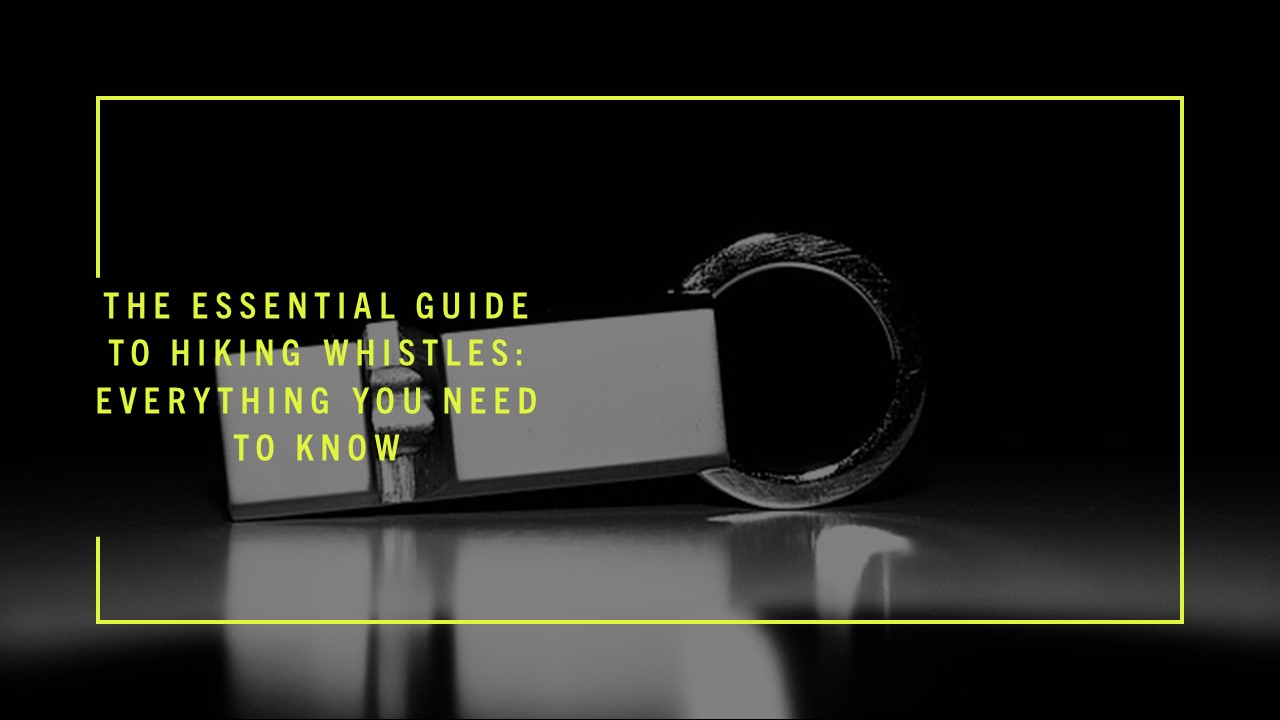Hiking and backpacking are among the most cherished ways to enjoy nature’s wonders, aren’t they? I can hardly resist the allure of embarking on a new adventure every time I see a trail map or a backpacking itinerary. But I want to discuss an often overlooked yet essential piece of hiking gear today – the humble hiking whistles. I’m sure many of you carry a multitool, a flashlight, perhaps a compass, and a map (or maybe you’re a GPS kind of person) – but do you always have a whistle on hand?
You might think of a whistle as merely an accessory, but it can be a lifesaver when situations take an unexpected turn. From alerting fellow hikers about your location to signaling for help in emergencies, a reliable whistle is an integral part of your safety toolkit.
In this article, I’m going to delve deep into the world of hiking and backpacking whistles. I’ll look at the best whistles available on the market, how to use them, and why they’re such an important piece of your outdoor kit. Whether you’re a seasoned hiker or just getting your boots dusty, I’ve got you covered.
Remember, your safety is paramount, and having the right gear can make all the difference. So, stick with me as I blow the lid off this topic!
The Necessity of a Hiking Whistle
You know, when I first started hiking, I never really thought much about carrying a whistle. I mean, why would I need one? I have my map, my compass, my phone with GPS, and I always let someone know where I’m going before I head out on a trail. But over time, I came to understand that a whistle isn’t just an optional piece of gear. It’s a necessity.
Let’s consider this scenario: You’re out in the wilderness, soaking in the beauty of the landscape, when suddenly you lose your footing and twist your ankle. Ouch! It’s painful, and now you can’t move as quickly as before. You realize that getting back will take much longer than planned, and it’s going to be dark soon.
Or perhaps you’ve unintentionally strayed off the trail, and now you’re unsure about the way back. You shout for help, but your voice is carried away by the wind, barely making a dent in the vastness of the outdoors.
In both situations, a hiking whistle can be a real lifesaver. It’s small and lightweight, yet it can produce a loud, piercing sound that carries much further than the human voice. This sound can alert other hikers, attract attention, or scare off animals. Furthermore, in an emergency situation, you may not have the physical strength or the breath to keep shouting for help, but blowing a whistle? That’s much less taxing.
In many cases, search and rescue teams are trained to listen for whistle signals. Three blasts on a whistle is a universally recognized distress signal, which means “Help Me”. This simple, compact tool could be the key to ensuring your safety when things don’t go as planned.
So you see, carrying a whistle while hiking isn’t just a good idea, it’s an essential safety measure. And since they’re small, light, and easily attachable to a backpack or around your neck, there’s really no reason not to have one. Next, I’ll explore what features you should consider when picking out the perfect hiking whistle.
Understanding a Safety Whistle for Hiking
So, now that you understand the importance of carrying a whistle, let’s dig into what exactly you should be looking for when you select one for your hiking adventures. Not all whistles are created equal, and it’s crucial to find one that’s specifically designed for outdoor safety. Here are some key factors to consider:
- Loudness: This is arguably the most important characteristic of a good hiking whistle. When you’re in a situation where you need to use it, you want your sound to carry as far as possible. Look for whistles that can reach at least 100 decibels. To put it in perspective, that’s about as loud as a motorcycle.
- Durability: Hiking can be tough on your gear. Your whistle may end up dropped, stepped on, or exposed to harsh weather conditions. Therefore, a good hiking whistle needs to be robust and durable. Consider whistles made from tough plastics, or metals like brass or stainless steel.
- Pea Vs Pea-less: Whistles can be either ‘pea’ or ‘pea-less’. A ‘pea’ whistle has a small ball inside that rattles around to create a trilling sound, while a ‘pea-less’ whistle does not. While ‘pea’ whistles can be loud and attention-grabbing, the ‘pea’ can jam or freeze in cold conditions. Thus, many hikers prefer ‘pea-less’ whistles for their reliability.
- Size and Weight: As with any piece of hiking gear, you want your whistle to be as light and compact as possible. Luckily, most hiking whistles are tiny and weigh only a few grams so they won’t add much to your load.
- Accessibility: In an emergency, you’ll need to access your whistle quickly. Therefore, it’s best to have it on a lanyard around your neck, or attached to your backpack strap. Some whistles come with clips or carabiners for this purpose.
- Color: While it might seem like a minor detail, the color of your whistle can be important. Brightly colored whistles are easier to spot in your bag or if you drop them on the trail.
Understanding these characteristics will help guide your choice when you’re in the market for a hiking whistle. In the next section, I’ll share with you my top picks for the best hiking whistles, considering all these key features. Stay tuned!
Top 5 Best Hiking Whistles
Fantastic! Now you know what to look for in a hiking whistle. Armed with this knowledge, I’ve compiled a list of my top 5 best hiking whistles, each chosen for its unique strengths. Let’s get to it.
- HyperWhistle The Original Worlds Loudest Whistle When it comes to loudness, nothing beats the HyperWhistle. As the name suggests, this whistle can produce an incredible sound up to 142 decibels. It’s made from durable, waterproof materials and is compact enough to carry easily. Remember, it’s super loud, so make sure to use it responsibly!
- Shoreline Marine Safety Whistle This whistle is made from plastic, which makes it lightweight and resistant to rust. It’s designed to work in both wet and dry conditions, making it a great choice for hikers who like to brave all kinds of weather. And yes, it’s very loud!
- Fox 40 Sonik Blast CMG Whistle The Fox 40 Sonik Blast is a pea-less whistle that can reach up to 120 decibels. It’s trusted by referees and rescue professionals worldwide. It also has a cushioned mouth grip for added comfort, a nice little extra.
- The Acme Tornado 635 Whistle Here’s a whistle with a unique design that’s known for its high-pitched, dual-tone sound. The Acme Tornado is compact, pea-less, and easy to blow. It’s also available in various colors, which can be a fun personal touch.
- Vigilant PPS8G Personal Alarm Safety Whistle The Vigilant is a bit of a twist on the classic whistle. It’s an electronic whistle that can emit a sound of 130 decibels at the push of a button. It even includes a built-in LED light, which can be extremely helpful in the dark.
These are my top 5 picks for the best hiking whistles. Remember, the best whistle for you will depend on your specific needs, environment, and personal preference. Choose one that resonates with you and ensures your safety during your outdoor adventures. In the next section, I’ll talk about how to use a hiking whistle in case of emergencies.
How to Use an Emergency Hiking Whistle
Excellent, I’ve now covered why you need a hiking whistle and which ones to consider. The next crucial step is knowing how to use your whistle effectively, particularly in an emergency situation. Let’s dive in!
- The Universal Distress Signal: Firstly, it’s important to understand that there’s a universally recognized signal for distress – three short blasts on your whistle. This pattern is internationally known and signals that you need help. If you’re lost, injured, or in danger, use this pattern to alert others of your situation. Pause between each series of blasts to listen for a response.
- Regular Intervals: If you’re in an emergency situation, it’s recommended to blow your whistle in sets of three blasts every few minutes. This conserves your energy while also increasing your chances of being heard.
- High Points: Sound travels further when there are fewer obstacles in its path. If you can safely reach a higher point, such as a hill or ridge, use your whistle from there to maximize its reach.
- Attracting Attention: Even if you’re not in immediate danger, a whistle can still be useful. For instance, if you get separated from your group, a couple of quick blasts on your whistle can attract your companions’ attention.
- Scaring Off Animals: In some situations, a loud whistle blast can scare off curious or threatening wildlife. However, this should be used as a last resort. It’s generally better to avoid encounters with wild animals where possible.
- Non-Emergency Communication: While the “three blasts” signal is standard for emergencies, you can develop your own codes with your hiking group for non-emergency communication. For example, two blasts could mean “gather at camp,” while one long blast might signal “I’ve found something interesting.”
Remember, a whistle should primarily be used for emergency situations while out hiking or backpacking. It’s a powerful tool and can save your life if used correctly. However, unnecessary or misuse of a whistle can lead to confusion or even initiate a needless search and rescue operation. Always use your hiking whistle responsibly.
Next, I’ll dive into the role of whistles in the context of backpacking. Stick around.
The Role of Whistles in Backpacking
While a whistle’s primary role might be to signal distress, it plays a far larger part in your backpacking adventures than you might initially realize. Even though we’ve discussed how critical a whistle is for hiking, backpacking adds an extra layer of complexity due to its long, often more remote nature. Let’s look at how a whistle fits into your backpacking endeavors:
- Extended Trips and Increased Risks: Backpacking often involves more extended trips into remote wilderness areas, where risks are naturally higher. In these situations, having a reliable way to signal for help, like a whistle, becomes even more crucial.
- Group Communication: In larger backpacking groups, maintaining communication can be a challenge, especially in dense forests or over vast distances. Whistles can come in handy here, providing a simple means to communicate non-verbally using pre-agreed signals.
- Deter Wildlife: In some parts of the world, backpacking can bring you closer to potentially dangerous wildlife. A loud whistle can often scare off curious or threatening animals, enhancing your safety.
- Multi-Functional Tools: Many modern backpacking whistles come with added features such as a compass, thermometer, or even a small mirror. These multi-tools can be incredibly useful, saving you space and weight in your backpack.
- Peace of Mind: Ultimately, carrying a whistle while backpacking provides peace of mind. It’s comforting to know that you have a powerful tool at your disposal if you ever find yourself in a sticky situation.
With these points in mind, it’s evident that a whistle plays a significant role in backpacking. It’s more than just a safety device; it’s a multi-functional tool that every backpacker should have. In the next section, I’ll explore my top pick for the best emergency whistle for backpacking and why I’ve chosen it.
Best Emergency Whistles for Backpacking
When it comes to backpacking, where you may find yourself in more remote and challenging environments, having a reliable emergency whistle is paramount. Based on my experiences and the key features I’ve discussed, my top pick for the best emergency whistle for backpacking is the Fox 40 Sonik Blast CMG Whistle.
Why the Fox 40 Sonik Blast, you may ask? Well, here’s why:
- Volume: This whistle is incredibly loud. It can reach up to 120 decibels, which can be heard from miles away. In a serious emergency, being able to project a loud sound could make all the difference in getting help quickly.
- Pea-less Design: The Fox 40 Sonik Blast whistle is pea-less, meaning it can operate in all weather conditions, even extreme cold, without the risk of a pea freezing or jamming the whistle.
- Comfort: This whistle features a cushioned mouth grip (CMG), making it more comfortable to hold in your mouth if you’re injured or need to have your hands free.
- Durability: The Sonik Blast is made from durable, high-impact thermoplastic material, making it robust enough to survive the rigors of backpacking.
- High-Visibility Colors: This whistle is available in bright colors, making it easy to spot in your backpack or if you drop it on the trail.
However, the best whistle for you will depend on your specific needs and circumstances. Other excellent alternatives include the HyperWhistle The Original Worlds Loudest Whistle, which offers extreme loudness, and the Vigilant PPS8G Personal Alarm Safety Whistle, which provides additional features like an LED light.
In the next section, I’ll be diving deeper into the best whistle for general backpacking use, beyond just emergency situations. Join me as I explore further.
Best Backpacking Whistles
Backpacking takes us on diverse adventures. From trekking through high mountains to walking amidst dense forests, every trip is unique. Thus, the perfect whistle for backpacking should be versatile enough to meet various demands. For this reason, my top recommendation for the best backpacking whistle is the UST JetScream Micro Whistle.
Here’s why I believe the UST JetScream Micro Whistle is the ideal choice:
- High-Pitched Sound: The UST JetScream Micro Whistle is one of the loudest of its size, producing a whistle of up to 112 decibels. But it’s not just the loudness that matters; the whistle produces a high-pitched sound that can be heard over most natural and man-made noises.
- Pea-less Design: Similar to my previous recommendation, this whistle also employs a pea-less design. This feature makes it reliable in all weather conditions, a crucial factor in unpredictable outdoor environments.
- Compact and Lightweight: For backpackers, every ounce matters. The JetScream is very compact and light, adding minimal weight to your pack. But don’t let the size fool you; this tiny tool packs a mighty punch!
- Waterproof and Buoyant: This whistle floats and works when wet, which makes it an excellent choice for backpacking trips involving river crossings, canoeing, or sudden rain showers.
- Durable: Made with durable ABS plastic, the JetScream can withstand harsh conditions and rugged use, making it ideal for long, challenging backpacking trips.
- Versatile: With its lanyard attachment, you can hang this whistle around your neck, attach it to your backpack, or even to your keychain, ensuring it’s within easy reach when needed.
While the UST JetScream Micro Whistle is my top pick for a general backpacking whistle, the choice ultimately depends on your personal needs and preferences. Always consider the factors I discussed earlier to make a decision that best suits your backpacking style and requirements.
Conclusion
Well, we’ve journeyed far and wide in the world of hiking and backpacking whistles. Who knew such a compact tool could hold so much importance, right? From the why to the which, I’ve covered it all. To summarize:
A whistle is an essential safety device for hikers and backpackers alike. Its compact size and light weight make it an easy addition to any backpack or pocket, but its potential impact in an emergency situation is huge. In fact, it can be a real lifesaver.
When choosing a whistle, there are several key features to consider – loudness, durability, design (pea or pea-less), size, weight, and accessibility. The best whistle for you will depend on your specific needs and the nature of your hiking or backpacking adventures.
I’ve recommended several whistles based on these criteria, including the HyperWhistle The Original Worlds Loudest Whistle, the Shoreline Marine Safety Whistle, the Fox 40 Sonik Blast CMG Whistle, the Acme Tornado 635 Whistle, the Vigilant PPS8G Personal Alarm Safety Whistle, and the UST JetScream Micro Whistle. These choices range from the loudest to ones with additional features like LED lights, but all are robust and reliable options.
Remember, owning a whistle isn’t enough – knowing how to use it is vital. Always signal distress with three blasts, and use regular intervals to conserve energy while maximizing the chance of being heard.
In conclusion, never underestimate the power of a simple whistle. When used correctly, this small device can provide a lifeline in unexpected situations and offer peace of mind during your hiking and backpacking adventures. Now that you’re equipped with all the knowledge, I hope you find the whistle that sings the right tune for you.
Since you’ve made it this far, which tells me you’re serious about your hiking and backpacking safety. Now it’s time to take the next step.
Don’t delay. I encourage you to take a moment now to review your current outdoor gear. Is a reliable whistle part of your kit? If not, now’s the time to make that critical addition. If you already own one, does it meet the essential features we’ve discussed? Is it loud enough, durable, and easy to reach in an emergency?
Remember, investing in a quality whistle isn’t just buying a piece of gear; it’s investing in your safety and peace of mind. Whether you prefer the extraordinary loudness of the HyperWhistle, the added comfort of the Fox 40 Sonik Blast CMG, the high-pitched sound of the UST JetScream Micro, or the multifunctionality of the Vigilant PPS8G, make your choice today.
Remember, adventure awaits, but safety should never be compromised. Now go out there, be loud, and make your outdoor journeys memorable and safe!
And, don’t forget to share your experiences and tips with us here. We’d love to hear from you about your adventures and how your whistle served you. Happy hiking and backpacking, everyone!










